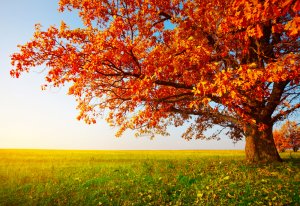Now that we’re officially into Fall  and enjoying some cooler temperatures; it’s time to reduce the watering times on your irrigation controllers. With less evaporation occurring, the landscape doesn’t need to be watered as often as during the summer months. My general rule of thumb is: cut watering times in half during Fall and Spring.
and enjoying some cooler temperatures; it’s time to reduce the watering times on your irrigation controllers. With less evaporation occurring, the landscape doesn’t need to be watered as often as during the summer months. My general rule of thumb is: cut watering times in half during Fall and Spring.
If you don’t really know how much you should be watering to begin with, let me go over the 3 basic things to look at to determine how long the system should be running because, there’s no point in having specialized heads, a shady yard, and native plants if everything is going to run for 20 minutes no matter what it is. Unfortunately, I see that happen a lot.
Amount of Light
It may seem obvious, but I’m going to come out and say it anyway—shady areas require less water than sunny areas. If you have good tree coverage and areas of the yard receive less than 6 hours of direct sunlight daily, that’s considered a shady yard. So, when entering time into your controller, you know that the times should be higher for the sunny spots and lower for the shady ones.
Head Type
There are two main sprinkler head types—rotor and spray. There is also drip irrigation, which technically has no head at all!
- Rotor heads rotate, they turn, so they are not watering the same area the entire time they are running, therefore, they need to run for a longer period of time than spray heads.
- Spray heads are stationary, they pop-up and stay watering the same spot the entire time; they can run for a shorter amount of time than rotors.
- Drip irrigation is different. Drip typically emits water very slowly, very minimally, so it oftentimes needs to run for longer periods—30 minutes at minimum or much longer in many cases.
Plant Material
Landscape (read: living plant) material is the last component of the irrigation scheduling trifecta. It may be obvious as well, but it does need to be said—areas with no vegetation really don’t need to be watered. The bare ground will just be muddy. Same goes for rocky paths, they don’t grow. Mulched areas don’t grow. Driveways, sidewalks, patios, and decks don’t grow. Pools don’t need to be filled by the sprinklers.
Native plants, established shrubs, or other established perennials do not, I repeat, do not need the same amount of water as the grass. That’s why you’ve planted them—they are native and require less water to survive. They are made for our climate and weather conditions. So, turn those stations off completely in the fall, winter, and spring and just water when they look stressed (i.e. droopy leaves, limbs first thing in the morning).
You may have picked up that there’s no exact time that works for every station or even every yard! Irrigation systems unfortunately aren’t just a turn it on and forget it. It will take a little tweaking to determine how few minutes the yard will perform well on, and it may need to be changed every year as the trees grow and give out more shade.
Here’s a watering schedule I follow, when irrigation is necessary during the Fall months:
Fall—October, maybe November
Set controllers for 1 start time for all lawn types.
Plant |
Exposure |
Type of Sprinkler Head |
How Often to Water |
Runtime (minutes) |
| St. Augustine | sun | spray | as needed, max. 1x/wk | 10 to 15 |
| rotor | as needed, max. 1x/wk | 15 to 20 | ||
| shade | spray | rarely, 1x per 2 wks | 15 | |
| rotor | rarely, 1x per 2 wks | 20 | ||
| Bermudagrass | sun | spray | rarely, 1x per 2 wks | 15 |
| rotor | rarely, 1x per 2 wks | 20 | ||
| shade | spray | rarely, 1x per 2 wks | 10 | |
| rotor | rarely, 1x per 2 wks | 20 | ||
| Zoysia japonica (wide blade zoysia, El Toro, JaMur, Palisades) | sun | spray | as needed, max. 1x/wk | 10 to 15 |
| rotor | as needed, max. 1x/wk | 20 | ||
| shade | spray | rarely, 1x per 2 wks | 15 | |
| rotor | rarely, 1x per 2 wks | 20 | ||
| Common shrubs | sun | spray | rarely, 1x per 2 wks | 10 to 15 |
| rotor | rarely, 1x per 2 wks | 20 | ||
| shade | spray | rarely, 1x per 2 wks | 15 | |
| rotor | rarely, 1x per 2 wks | 20 | ||
| Common groundcovers | sun | spray | rarely, 1x per 2 wks | 10-15 |
| rotor | rarely, 1x per 2 wks | 20 | ||
| shade | spray | rarely, 1x per 2 wks | 15 | |
| rotor | rarely, 1x per 2 wks | 20 |


